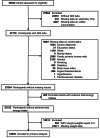Association of daily sitting time and coffee consumption with the risk of all-cause and cardiovascular disease mortality among US adults
- PMID: 38632571
- PMCID: PMC11022421
- DOI: 10.1186/s12889-024-18515-9
Association of daily sitting time and coffee consumption with the risk of all-cause and cardiovascular disease mortality among US adults
Abstract
Background: Sedentary behavior has been demonstrated to be a modifiable factor for several chronic diseases, while coffee consumption is believed to be beneficial for health. However, the joint associations of daily sitting time and coffee consumption with mortality remains poorly understood. This study aimed to evaluate the independent and joint associations of daily sitting time and coffee intakes with mortality from all-cause and cardiovascular disease (CVD) among US adults.
Methods: An analysis of a prospective cohort from the 2007-2018 National Health and Nutrition Examination Survey of US adults (n = 10,639). Data on mortality were compiled from interview and physical examination data until December 31, 2019. Daily sitting time was self-reported. Coffee beverages were from the 24-hour diet recall interview. The main outcomes of the study were all-cause and cardiovascular disease mortality. The adjusted hazard ratios [HRs] and 95% confidence intervals [CI] were imputed by Cox proportional hazards regression.
Results: Among 10,639 participants in the study cohort, there were 945 deaths, 284 of whom died of CVD during the follow-up period of up to 13 years. Multivariable models showed that sitting more than 8 h/d was associated with higher risks of all-cause (HR, 1.46; 95% CI, 1.17-1.81) and CVD (HR, 1.79; 95% CI, 1.21-2.66) mortality, compared with those sitting for less than 4 h/d. People with the highest quartile of coffee consumption were observed for the reduced risks of both all-cause (HR, 0.67; 95% CI, 0.54-0.84) and CVD (HR, 0.46; 95% CI, 0.30-0.69) mortality compared with non-coffee consumers. Notably, joint analyses firstly showed that non-coffee drinkers who sat six hours or more per day were 1.58 (95% CI, 1.25-1.99) times more likely to die of all causes than coffee drinkers sitting for less than six hours per day, indicating that the association of sedentary with increased mortality was only observed among adults with no coffee consumption but not among those who had coffee intake.
Conclusions: This study identified that sedentary behavior for more than 6 h/d accompanied with non-coffee consumption, were strongly associated with the increased risk of mortality from all-cause and CVD.
Keywords: Coffee Consumption; Mortality; National Health and Nutrition Examination Survey (NHANES); Sedentary behavior.
© 2024. The Author(s).
Conflict of interest statement
The authors declare no competing interests.
Figures
Similar articles
-
Does physical activity attenuate, or even eliminate, the detrimental association of sitting time with mortality? A harmonised meta-analysis of data from more than 1 million men and women.Lancet. 2016 Sep 24;388(10051):1302-10. doi: 10.1016/S0140-6736(16)30370-1. Epub 2016 Jul 28. Lancet. 2016. PMID: 27475271
-
Physical activity attenuates the excess mortality risk from prolonged sitting time among adults with osteoporosis or osteopenia.Endocrine. 2024 Sep;85(3):1365-1378. doi: 10.1007/s12020-024-03871-8. Epub 2024 May 17. Endocrine. 2024. PMID: 38760616
-
Relationship between timing of coffee and tea consumption with mortality (total, cardiovascular disease and diabetes) in people with diabetes: the U.S. National Health and Nutrition Examination Survey, 2003-2014.BMC Med. 2024 Nov 11;22(1):526. doi: 10.1186/s12916-024-03736-x. BMC Med. 2024. PMID: 39523296 Free PMC article.
-
Coffee and tea consumption and cardiovascular disease and all-cause and cause-specific mortality in individuals with diabetes mellitus: a meta-analysis of prospective observational studies.Front Nutr. 2025 Jun 2;12:1570644. doi: 10.3389/fnut.2025.1570644. eCollection 2025. Front Nutr. 2025. PMID: 40525136 Free PMC article.
-
The Dose-Response Associations of Sedentary Time with Chronic Diseases and the Risk for All-Cause Mortality Affected by Different Health Status: A Systematic Review and Meta-Analysis.J Nutr Health Aging. 2020;24(1):63-70. doi: 10.1007/s12603-019-1298-3. J Nutr Health Aging. 2020. PMID: 31886810
Cited by
-
Relationship between longer sleep and serum neurofilament light chain in american adults: evidence from the 2013-2014 US national health and nutrition examination survey.BMC Public Health. 2024 Oct 5;24(1):2717. doi: 10.1186/s12889-024-20184-7. BMC Public Health. 2024. PMID: 39369188 Free PMC article.
-
Sedentary Behavior and Its Association With Psychological Well-Being and Sleep Quality in Adolescents: Evidence from a Propensity Score Analysis.Psychol Res Behav Manag. 2025 Feb 7;18:281-298. doi: 10.2147/PRBM.S508382. eCollection 2025. Psychol Res Behav Manag. 2025. PMID: 39944523 Free PMC article.
-
Sedentary behavior accelerates biological aging mediated by body mass index in adults.Sci Rep. 2025 Jul 1;15(1):21356. doi: 10.1038/s41598-025-06325-x. Sci Rep. 2025. PMID: 40594876 Free PMC article.
-
Coffee consumption as a double-edged sword for serum lipid profile: findings from NHANES 2005-2020.Front Nutr. 2025 Jul 9;12:1606188. doi: 10.3389/fnut.2025.1606188. eCollection 2025. Front Nutr. 2025. PMID: 40704303 Free PMC article.
-
Physical Activity and Sedentary Behavior Among Chinese Adults - 10 PLADs, China, 2022-2023.China CDC Wkly. 2025 Jan 3;7(1):6-9. doi: 10.46234/ccdcw2025.002. China CDC Wkly. 2025. PMID: 39801822 Free PMC article.
References
-
- Patterson R, McNamara E, Tainio M, de Sá TH, Smith AD, Sharp SJ, et al. Sedentary behaviour and risk of all-cause, cardiovascular and cancer mortality, and incident type 2 diabetes: a systematic review and dose response meta-analysis. Eur J Epidemiol. 2018;33(9):811–29. doi: 10.1007/s10654-018-0380-1. - DOI - PMC - PubMed
Publication types
MeSH terms
Substances
Grants and funding
- a sub-project/the Priority Academic Program Development of Jiangsu Higher Education Institutions (PAPD)
- a sub-project/the Priority Academic Program Development of Jiangsu Higher Education Institutions (PAPD)
- a sub-project/the Priority Academic Program Development of Jiangsu Higher Education Institutions (PAPD)
- a sub-project/the Priority Academic Program Development of Jiangsu Higher Education Institutions (PAPD)
- a sub-project/the Priority Academic Program Development of Jiangsu Higher Education Institutions (PAPD)
- a sub-project/the Priority Academic Program Development of Jiangsu Higher Education Institutions (PAPD)
- a sub-project/the Priority Academic Program Development of Jiangsu Higher Education Institutions (PAPD)
- a sub-project/the Priority Academic Program Development of Jiangsu Higher Education Institutions (PAPD)
- a sub-project/the Priority Academic Program Development of Jiangsu Higher Education Institutions (PAPD)
LinkOut - more resources
Full Text Sources
Research Materials


